The Iberians created the first states in Andalucia. They are recognised for their large stone statues of animals, their oppidums and the Iberian Damas of Baza and Elche.
By Nick Nutter | Updated 13 Nov 2022 | Andalucia | History |
Login to add to YOUR Favourites or Read Later
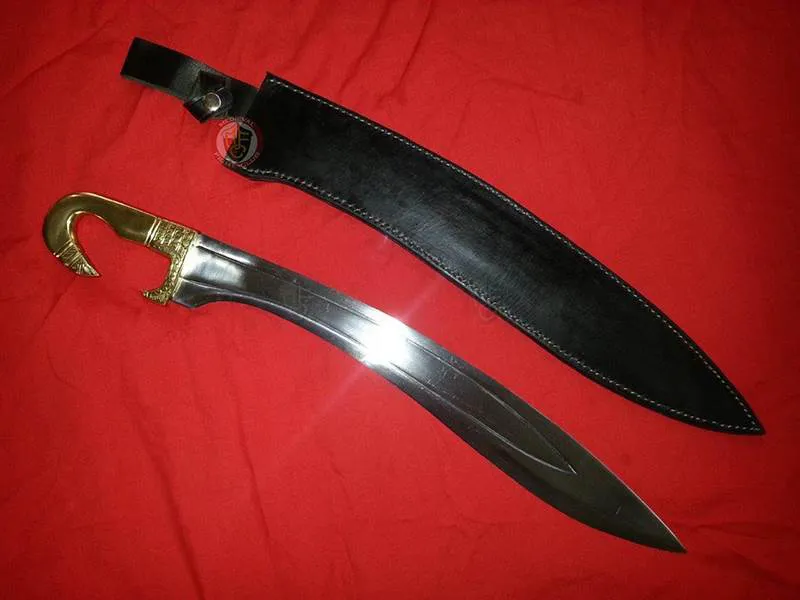
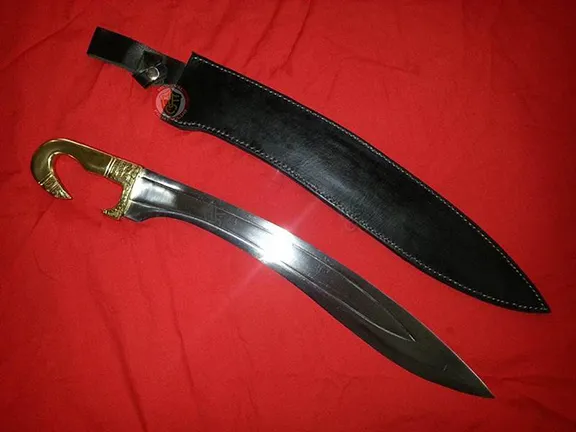
Falcata or Gladius Hispaniensis
The Iberians emerged as a cultural unit during the 8th century BC although traces of what was to be their culture, on the eastern and southern coasts of Spain, go back as far as 3000 BC.
Hecataeus of Miletus was the first known historian to use the term Iberia, which he wrote of about 500 BC. The name derives from the ancient inhabitants whom the Greeks called Iberians, probably from the Ebro (Iberus) area, the peninsula's second longest river (after the Tagus).
With a territory that extended from the French border as far as Málaga and hundreds of kilometres inland, the Iberians established the first proper state in the Iberian peninsula.
Their culture survived the Punic period; indeed, their culture was supplemented by fashions, ceremonies, architecture and beliefs brought from the eastern Mediterranean, and they thrived during the following Roman period. Many of the settlements are referred to as Ibero-Romano, signifying this continuity. Although the Iberian people lived on under the Visigoths and Moors, their culture changed beyond recognition.
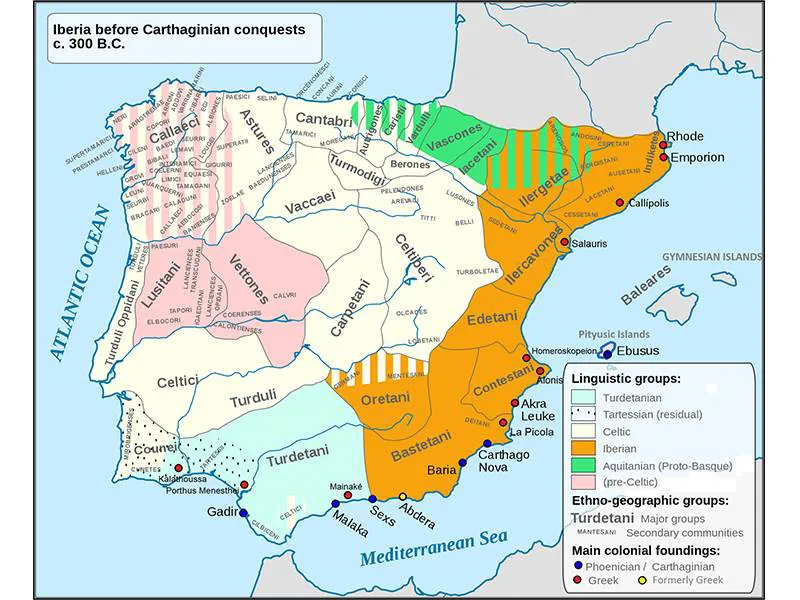
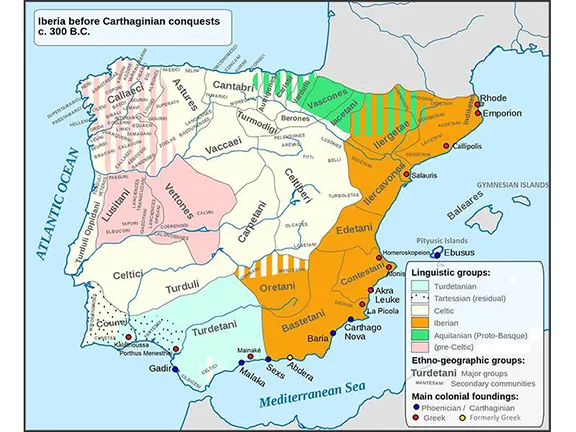
Iberian Territory 300 BC
Variously called Bastetani, Bastitani or Bastuli, they were the biggest Iberian tribal confederation in area, they dwelt in a territory that included large areas of the Mediterranean coast and the Sierra Nevada, in what today are parts of the modern regions of Murcia, Castilla-La Mancha and Andalucia. Within Andalucia their territory extended into the provinces of Jaén, Almería, Granada and Málaga. Basti (today's Baza in Granada province) was their main centre in Andalucia.
The Oretani or Oretanii were Iberians that lived in northeastern Andalusia, in the upper Guadalquivir river valley, eastern Sierra Morena, and the southern area of present-day La Mancha.
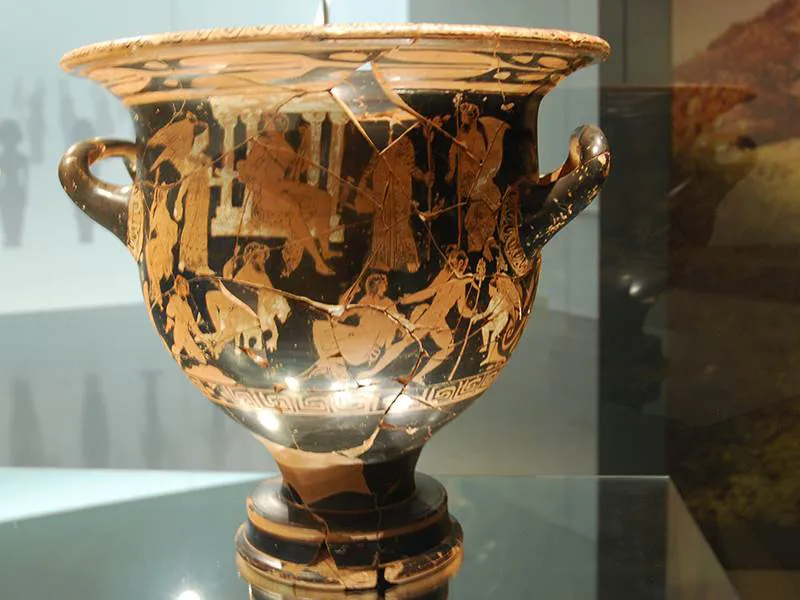
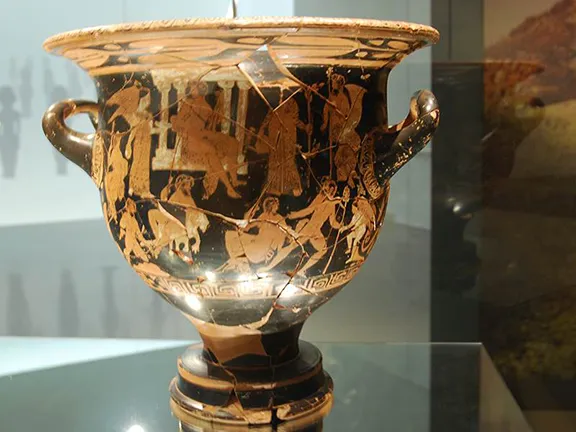
Greek Ceramics from Oppidum
The Iberian society centred around the oppidum, a fortified settlement, that housed a chieftain, artisans, functionaries and an agrarian population. Outside the oppidum there was often a necropolis and one or more sanctuaries. Each oppidum controlled an area of agricultural land that was farmed by the inhabitants and an area that was farmed by people that lived in remote and scattered settlements. The largest oppidum were the centres and nominally at least, controlled a number of surrounding oppidii and housed a ‘prince’. Work and research is still very much ongoing to determine which centres controlled which oppidii and identify more oppidum. Many are undoubtably now beneath more modern buildings, such as the oppidum of Ilturir / Iliberis, now buried beneath the Albaicín district in Granada city. From the work that has been done to date, much of it in the first two decades of the 21st century, a reasonable picture can be drawn of how the Iberians lived.
Most Iberian families consisted of a couple with three or four sons or daughters. Their house was made of stone plinths, adobe or bleached walls and a roof composed of wooden beams, straw thatch and mud. Many houses had several rooms and a courtyard, some even had a first floor. The smallest house had an area of about 70 square metres.
Houses had no foundations. The base was settled directly on the ground and was made of mud stones to a height of between 25 and 50 cms. This acted as insulation and a foundation on which to build the walls. The walls were either a mix of earth and straw, a sort of wattle and daub, or adobe mud bricks. Sometimes crushed pottery was introduced to the daub to create a primitive conglomerate. The roof was as described above.
The Urban centre was planned around parallel streets that gave access to individual buildings.
The main house in the oppidum, housing the chief (sometimes called a prince in the Spanish literature), had a large courtyard and many rooms.
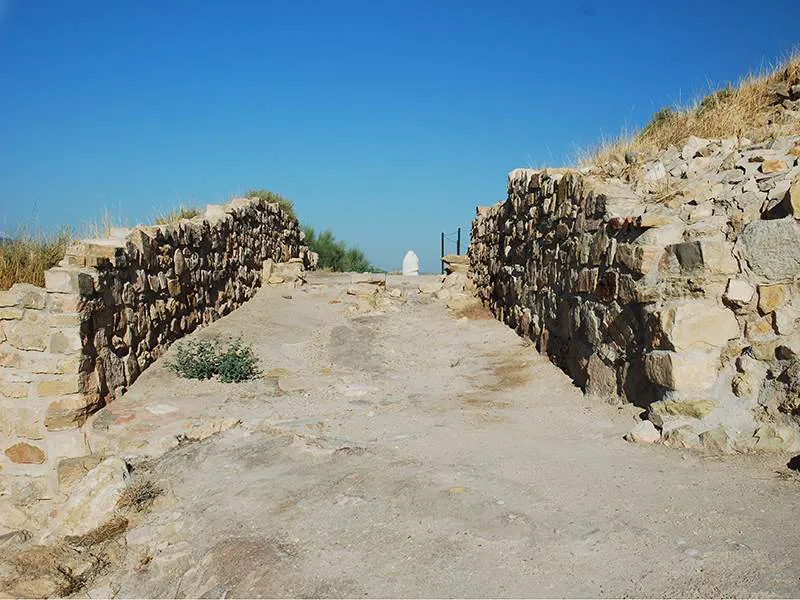
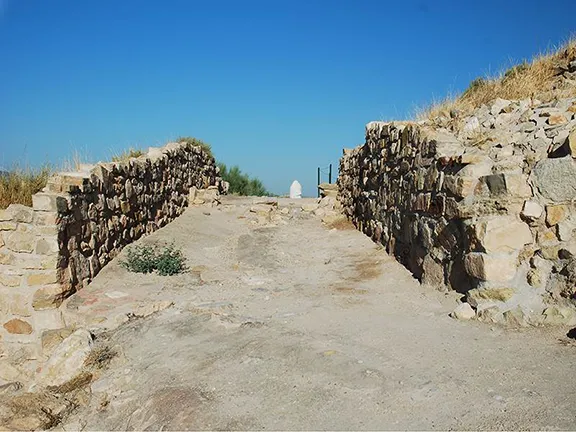
The Iberians kept a full range of farm animals; cows, pigs, sheep, goats, chickens and donkeys. Cows were primarily for meat and hides, it was the sheep and goats that provided wool and the milk that was made into cheeses. Pigs were allowed to roam free in the forests, foraging on the acorns whilst cows were kept closer to home. Domestic dogs were used to herd all the animals. The meat supply was supplemented by hunting deer and wild boar and large scale gathering of snails and frogs. Iberian sanctuaries have revealed small amounts on animal bones evidently used as offerings.
Surrounding the oppidum is a stone wall with bastions. Normally the wall was built sloping into the natural contours of the hill it encompassed. Stone was used from nearby locations so it could be sandstone or limestone, depending on the geology of the area. The roughly dressed stones were bonded using a mortar and often plastered and whitewashed so that they were a prominent sight in the landscape. The oppidii were built in places that dominated agricultural land, resources such as metal ores, and trading routes. It seems that the primary function of the oppidum was not defense. The walls were neither high enough at 5 metres, nor vertical enough to dissuade a determined attacker. They were rather a statement of the power and influence of the chief.
The inhabitants had a constant programme of repair and renovation, many oppidii were inhabited for a thousand years.
The Iberians grew wheat and barley, peas and beans and fruit trees including figs, almonds, grapes and olives. They also collected acorns and nuts from surrounding woodland. In that respect they were not that different to their long-passed ancestors, the Neolithic people. What is different are the tools used in the field. Iron sickles have been found in Iberian settlements, with curved and serrated thin edges. They are hafted to wooden handles held in place by iron rivets; not at all unlike sickles of today.
The plough also came into use during this period. The iron ploughshare was towed behind one or two oxen. It allowed for deeper ploughing than the older and lighter, wooden ploughs that were little better than scratch sticks, and the whole process was faster using oxen than human power alone.
Fertilisers were commonly used, the ash produced by burning stubble each year was ploughed back into the soil along with animal and human waste. The Iberians also knew the value of crop rotation, using the land for different crops in succeeding years. Grain was grown on land previously growing legumes. They also seem to have been introduced to the, almost science, of irrigation during the latter part of the Iberian period; an idea that was probably transmitted by traders from the east where irrigation had long been practiced.
Once cut, the grain had to be separated from the husk by threshing. The thresher consisted of several planks with cross timbers. The underneath had spikes inserted made from ceramics, iron or stone. This was run over the grain in a circular motion. A second method, described by Roman authors, was much simpler. Cattle were allowed to trample the grain. In both cases, threshing circles were used, many of which can still be seen.
Once threshed, the grain was thrown into the air using wooden forks and shovels. The wind blew the chaff from the grain. This process is known as winnowing.
The Iberians initially developed a system so that, if crops failed in one area, the oppidum could be supplied by neighbouring oppidum, each of which maintained a stored reserve of grain. This was to change.
One of the few goddesses known in the Iberian pantheon is Batatun, to whom all Iberians paid tribute. The tribute paid to the chief made up the stored reserve.
One of the innovations of this period is arboriculture, the cultivation, over many years, of fruit trees. In addition to those mentioned the cultivated plum and walnut started to appear.
The Iberians kept a full range of farm animals; cows, pigs, sheep, goats, chickens and donkeys. Cows were primarily for meat and hides, it was the sheep and goats that provided wool and the milk that was made into cheeses. Pigs were allowed to roam free in the forests, foraging on the acorns whilst cows were kept closer to home. Domestic dogs were used to herd all the animals. The meat supply was supplemented by hunting deer and wild boar and large scale gathering of snails and frogs. Iberian sanctuaries have revealed small amounts on animal bones evidently used as offerings.
The predominant landscape was that of the Mediterranean forest, holm oaks, oaks, pines and wild olives. Beneath the trees and in areas where trees had been cleared, were mastic, cistus, broom and rosemary. Juniper could be found on higher ground.
Alongside the rivers was what is known as riparian forest, a strip of willow, poplar, alder, ash and elm trees taking advantage of the wetter conditions to protect them from the normally hot and dry Mediterranean summer season.
Between the areas of woodland were clearings of cultivated ground and pasture. If more were needed, the Iberians employed a self-explanatory method known as cut and burn. Orchards, probably family owned, of almonds, figs and grapes and later, plums and walnuts, provided a lighter green contrast to the dark green Mediterranean forest. This patchwork of forest, orchards and cultivated land lasted until the 1st century BC when the Romans began the intensive cultivation of the olive which resulted in the serried rows of olive trees stretching from horizon to horizon seen today in provinces such as Jaén.
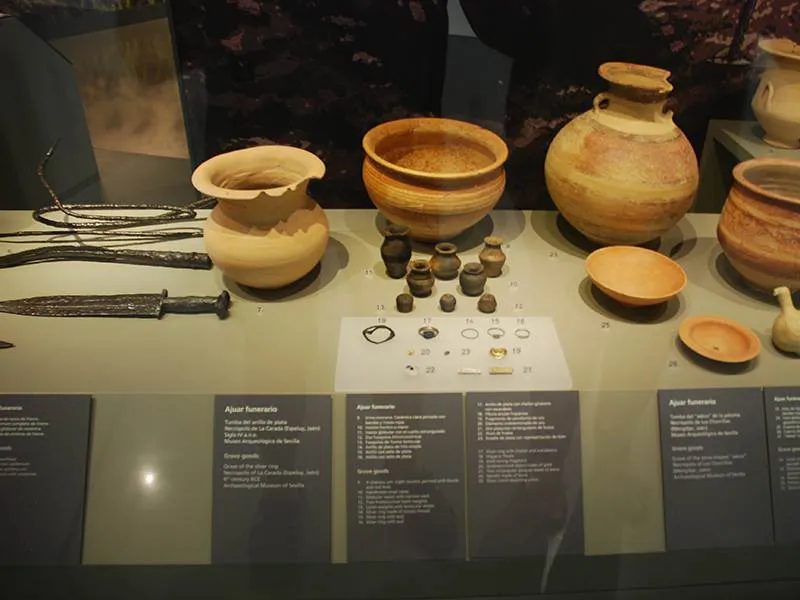
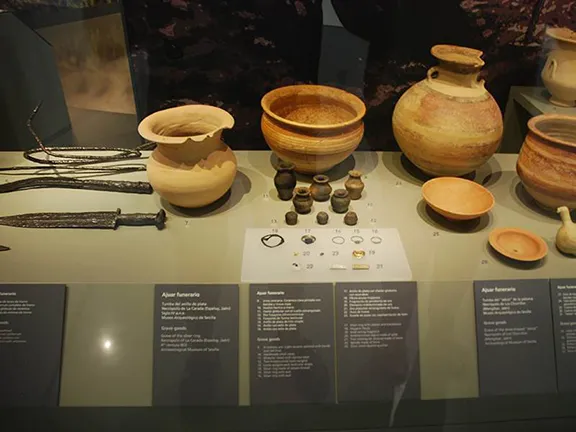
Iberian wheel thrown Ceramics
Four innovations appeared during the Iberian period, all probably introduced by the Phoenicians; good ideas that must have rapidly spread along the well-established trading networks since there is no direct evidence for any Phoenician or for that matter Greek, physical presence anywhere inland.
The first is the millstone. Two circular pieces of stone, the lower fixed and with a central hole to take a spindle, the upper rotated by means of a projecting handle. Grain was poured in through the top spindle hole, ground between the stones and ejected as flour into a chute to be gathered. The earliest rotating mills were found at Puente Tablas and date to the 4th century BC.
The second is the rotating potters wheel. Whilst no such wheels have been found, their use is evidenced by the fine ceramics that started to appear during this period. Even with the wheel, the pottery remained fairly plain, sometimes with red zigzag lines painted on as decoration.
In the pottery ‘industry’, a new type of oven was developed known as a three tier oven. The bottom tier was a pit dug into the ground. This was the seat of the fire. Above that was the second tier, a perforated surface on which the objects to be fired were placed. The holes allowed the heat and gases through without any need for the objects to be placed in direct contact with the fire. The third tier was an enclosed adobe structure that retained the heat. The earliest three tier ovens date to the late 7th century and early 6th century BC.
Iron started to be worked during the Iberian period. Whether the techniques and skills came from the Phoenicians or from the Celt-Ibero tribes that neighboured the Iberians to the northwest and north is still a matter of debate. Certainly the more artistic, ornamental, iron work is more reminiscent of the Celtic tribes than anything from the eastern Mediterranean. A workshop containing a good amount of iron slag, excavated at Puente Tablas in the vicinity of the ‘palace’, could be interpreted as a blacksmiths shop. The whole process of producing iron implements was a labour-intensive job. The iron ore was first dug and crushed at the mine. It was roasted and then placed in an oven with alternating layers of charcoal and lime. The resulting ‘pig iron’ was then formed into ingots and taken to the oppidii. There the blacksmith took over, heating the iron in a furnace that was normally a pit of charcoal superheated by bellows, and worked on an anvil to the desired shape. The first iron works have been dated to the 6th century BC. Iron agricultural tools, weapons and domestic appliances soon became widespread. Evidence indicates that finer tools, such as the falcate sword, were manufactured by metal working specialists, one step up the hierarchy from the blacksmith.
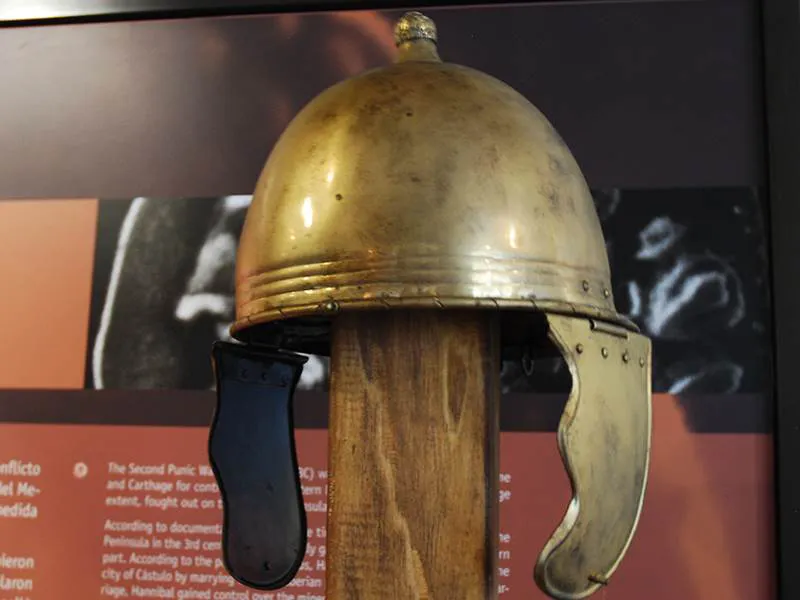
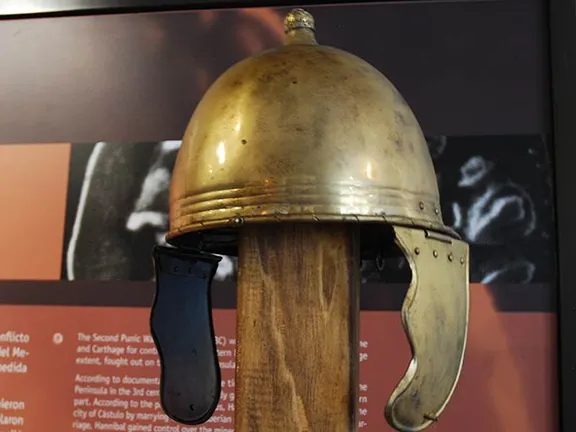
Iberian helmet
Bronze, silver and gold had been worked for millennia and reached a high art form with the Iberians. Specialists in small workshops produced bronze votive offerings, garment fasteners such as fibula, coins and some weapons. There are examples of fine jewellery with a core of bronze that were then gold plated. Silver was used to make crockery and jewellery. Goldsmiths produced jewellery and refined the process of using gold sheets and gold thread. Gold objects were considered so precious that they were inherited, they rarely appear in burial contexts, apart from earrings for some unknown reason.
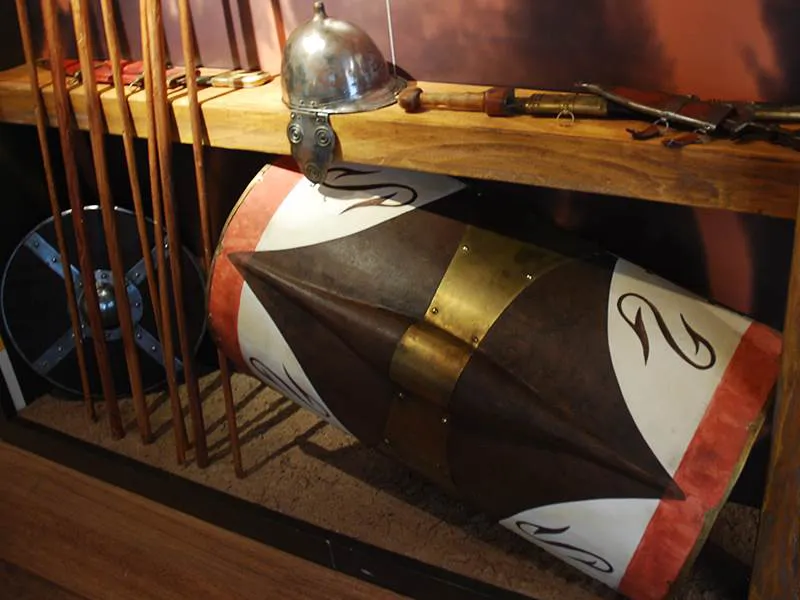

Scutum and Buckler Shields
All this domestic bliss and visions of an agrarian utopia belie the fact that conflict between the chiefs was not uncommon. Every inhabitant of the oppidum who was old enough to fight had to keep his falcate, a spear and a shield close to hand. The chief was expected to take the lead in battle and much of his power derived from his success on the battlefield. Most of the information about the Iberians and how they waged war comes from Roman authors writing after the 3rd century BC.
It seems that each oppidum had a core of semi-permanent soldiers, both infantry and light cavalry. The regular infantry were heavily armoured and carried a large Celtic type scutum shield, a curved rectangular shield some 1.5 metres high, a design borrowed by the Romans when their infantry tactics changed from the Hoplite formation to the phalanx or maniples formation more familiar to history students. A civic militia could be called upon if necessary, made up of inexperienced householders. These inexperienced troops carried a smaller shield called a buckler, a round shield up to half a metre in diameter, held in the fist. Both carried the famous Iberian designed Gladius Hispaniensis or falcata, a design of sword that would be taken up by the Romans themselves. Their tactics included raids into enemy territory, the purpose of which was to loot fields, steal cattle and any riches they came across. It was rare for an oppidum to be put under siege or even attacked, guerrilla tactics and ambushes were much more their style. Puente Tablas is one of those rare exceptions. Archaeological evidence is being revealed that indicates that, at some stage of its life, the oppidum was attacked and taken following a siege. Pitched battles were more common between small numbers of combatants. The Romans were amused to see the tactics of the opposing sides. They would take it in turns to charge and, at a suitable range, throw their javelins and then run back to their starting positions. Injury and death during these mock combats were rare.
The Iberian peninsula was renowned for its horses and the Iberians were skilled horsemen. The light cavalry were a key component of Iberian forces, considered by the Romans and Carthaginians to be the best in the western Mediterranean.
In the event of a common enemy appearing over the horizon, the chiefs would form temporary alliances to deal with the menace. By the 3rd century BC the Iberians were sufficiently sophisticated that one chief would be in overall charge of the army whilst individual chiefs would be in charge of their own contingents. It did not take long for the dominant chief to realise that if he retained his control during peaceful times he would command a large area and its people. For those wondering how that could happen; in prehistoric societies it was enough to promise the masses extra security and show you could provide it, throw a decent party on a regular basis to show how munificent you are and assemble a group of people who would extoll your virtues. Pretty much the same as 21st century politics really. The first states in Andalucia began to take shape.
Over a relatively short time span the organisation of society changed radically within the Iberian sphere. A society based on the reciprocity of gift and counter gift, essential in times of need, a system that favoured a fairly equal distribution of goods linked to a number of mythical ancestors became another society in which power was based on the ability of a few ‘chiefs’ to accumulate wealth and linking those higher echelon people to the lower classes by a covenant of faithfulness.
This new system has a label, ‘the patronage gentilic lineage’ and it resulted in a society where the control of resources and assets were held by the dominant lineage of the chief. By the loyal covenant, subjects abandoned their own lineage and adopted the chief’s. In return the chief gave them land to work at for a communal purpose, gave them access to specific tools and materials and allowed them to reside within the chief’s domain. In practice this system developed a number of levels and is called a patronage pyramid. Members of the pyramid had access to the lineage by consensus or agreement or by submission after military action. Those with desirable skills, metalworking, pottery making, weaving and so on gravitated towards an artisan class and those that traded in those products soon accumulated enough wealth to form a superior class, what we would today call a ‘middle class’. It was therefore possible to move up the pyramid and be rewarded with higher status and, for instance, a burial in the chief’s necropolis.
The most immediate problem that chiefs had to face in the transition from an inter dependant society to one more centralised was the threat of starvation. In bad years crops would fail. The Iberians developed a system of storage on three levels. Individual households had to store grain for reseeding the following season, dried legumes, dried fruit, and dried, salted and smoked meats and fish to sustain them through the winter. Each household contributed a portion of their crops and produce to the chief, or more practically, his officials, the first tax collectors. Part of that was kept as an emergency store to feed the populace and provide seed for the following season if they had experienced a lean growing season. Part was used to pay the non-producers, the chief and his family, his officials and to some extent and increasingly, the artisans and traders.
Apart from putting into place an administrative system, they developed efficient methods of storage and containing the produce. The amphora was ‘borrowed’ from the eastern world, it had been in use there since before 1500 BC and the Iberians also developed their own style of ceramic containers. They were also adept at producing esparto grass, wicker and animal skin containers. Large buildings were purpose built to store the communal reserves.
Alcoholic beverages had been produced for millennia, the Iberians had a fondness for barley and wheat beer, mead and wine. Most wine was home produced but the chiefs also imported it from the eastern Mediterranean in black glass containers with red and white figures painted on the surface. The containers were as prized as the contents.
Wine production seems to have started in the 8th or 7th centuries BC. Unlike other alcoholic beverages it was not initially available to everybody in the oppidum. At first it was a product reserved for the chief and his family. As production increased, under the control of the chief, it became available to the lower ranks of society. At the same time, imported wine became the prerogative of the chief and his family. After the Roman invasion, wines from favoured parts of Iberia were deemed to be better than Italian wines and a wine export market began, the Iberian wines being supplied to the Roman hierarchy all over the Roman Empire.
Olive oil is another interesting product. Archaeological evidence indicates that olive oil was not used as a cooking ingredient until very late in the Iberian period. It was used, mixed with colour pigments such as red and yellow ochre and fragrant herbs, to make ointments that formed part of the funeral goods, an early potpourri, and for cosmetic products.
Each household was expected to make its own garments and basic woven containers. For the latter, esparto grass and wicker were used to make ropes, mats and baskets. Both esparto and wicker need preparation before they can be used. They need cooking and beating to make them pliable. This artisanal industry has hardly changed since. Playa los Cocedores in Almeria is so named because the beach was used, well within living memory, as a location to cook the esparto grass grown locally.
Garments were primarily made from linen and wool. Both were spun. The spinning weights of different sizes found in domestic situations show that thread of different thicknesses was being produced. The weights can be seen in most ethnological and archaeological museums in the region, they are cone shaped ceramics with a hole through the centre. The looms used by the Iberians were mainly upright looms leaning against an internal wall. The baked clay loom weights are the only parts of this apparatus to survive.
The Iberians had a language that had developed after the first appearance of the Iberian culture about 700 BC. The written texts have, to date, only been partially translated and the actual language as it was spoken is unknown. The text appears to have two forms, that used in the south-eastern parts of the territory, and that used in the northeast. The former has been linked with the older, Tartessian texts found in the lower Guadalquivir, Huelva and Cadiz provinces, and southern Portugal. The language disappeared entirely after 200 BC when Latin became the predominant language.
It is interesting to speculate how the Iberian society would have developed if it had not been for the intervention of the Carthaginians during the Second Punic War, and the subsequent occupation of all the Iberian tribal lands by Rome.
In the early days of the Iberian people, from about 700 BC they had been influenced culturally by Phoenicians trading in the south western part of their territory and, primarily, by Greeks trading in the northeast as evidenced by the surfeit of Greek ceramics found in the Iberian territories and the amount of Greek influenced ornamentation and statuary, such as the Lady of Elche, or the Dama de Baza. Neither the Phoenicians nor the Greeks displayed any intentions of invading or occupying inland Andalucia, confining their role to traders on the coast. Following the 348 BC second treaty between Carthage and Rome, it was agreed to share influence in the Iberian peninsula but there were only minor incursions into the interior by the Carthaginians from the old Phoenician trading posts they had taken over following the collapse of the Phoenician trading network.
The Romans exercised negligible influence but the 348 treaty did in effect, cause the Greek cultural influence to reduce drastically. After 218 BC, the start of the Second Punic War, Iberian territories were invested by the armies of Carthage and Rome moving through their lands and occasionally coming to blows. Individual Iberian chiefs allied themselves with whoever they thought would be the victor. Their mercenary armies were a valued asset by both sides in the conflict. Seventeen years later, in 201 BC, the war was over and the Romans began to physically occupy Iberia. The occupation process actually started before the end of the war, about 208 BC, when Roman army veterans were allowed to occupy the old Carthaginian towns.
From 201 BC, the unique Iberian culture became increasingly subsumed by that of Rome and the Iberian culture as well as the prehistoric history of the Iberian peninsula came to an end.